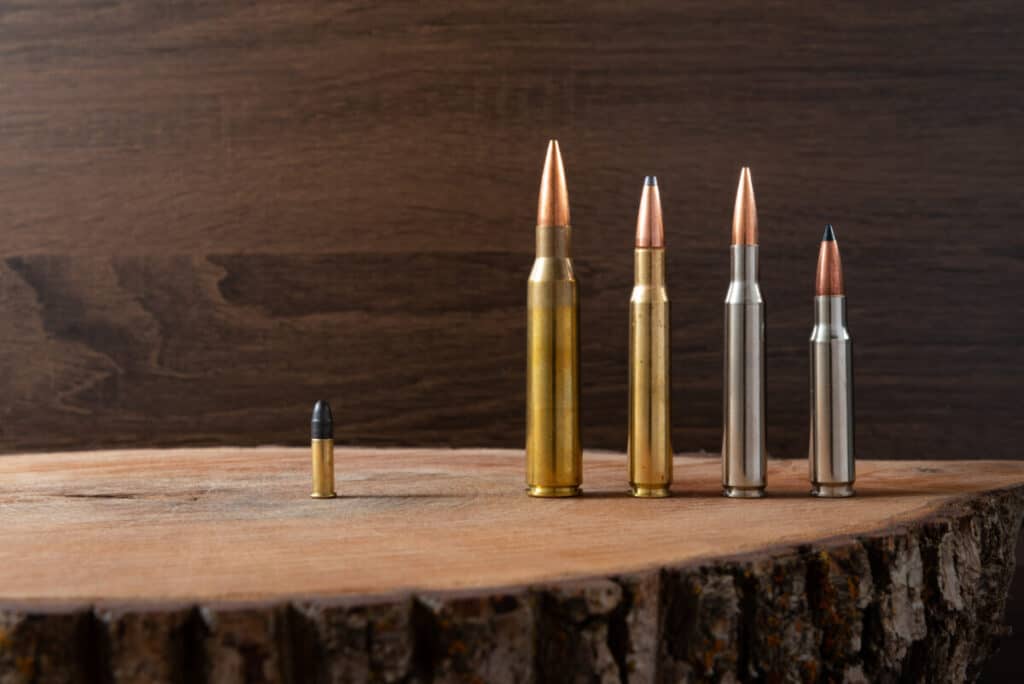Chart of all Rifle Calibers In Order, And Their Power

If you’re just getting started in learning about firearms, it can be really complicated to understand all the different calibers and what each cartridge is capable of. Let’s begin with understanding what caliber actually means.
“Caliber” is a measurement in inches of the internal width of a firearm’s barrel, and consequently the width of the bullet. A larger caliber such as .308″ means the bullet is physically wider than a bullet such as a .22″. Larger caliber bullets can cause more damage and generally weigh more; however, caliber only describes the bullet size but provides no information as to the cartridge’s speed or power.
Next, we need to understand what exactly a “cartridge” is, and how that differs from a bullet. A “Cartridge” refers to the entire firing unit: brass case, primer, gun powder, and projectile. The word “bullet” only refers to the action projectile that is shot through the barrel and hits the target.
Now that you understand that, things will start to make sense. Let’s take an example. The .308 Winchester and the .300 PRC are both the exact same caliber. They both shoot a .308 caliber bullet. Don’t be confused by the names of cartridges. Sometimes they round things off to make a nice marketing name (such as the .300 PRC when it’s really a .308) and sometimes they use other ways to measure so they can have a nice-sounding name.
Both the .308 and the .300 PRC can shoot the exact same bullet (projectile). For example, a 180-grain GMX bullet could be loaded and fired out of either cartridge. Bullet designs are mostly interchangeable between cartridges of the same caliber.
However, the .308 Winchester case is much smaller than the case of a .300 PRC. Thus, the .308 Winchester case can’t hold as much gun powder, so when it shoots the projectile, it won’t cause as much damage to the target.
Now you’re ready to see some numbers. On this chart, you’ll see the name of the cartridge, the caliber measurement for that cartridge, then an approximation of how big of an animal that cartridge could kill (much of which is highly debatable), and how much average energy the cartridge would produce at a typical hunting distance of 100 yards.
| Cartridge | Caliber | Suitable for Hunting Animals Up To… | Avg Muzzle Energy (ft-lbs) |
| .50 BMG | 0.51 | Anything with a pulse | 12600 |
| .458 Win Mag | 0.458 | Cape Buffalo | 5063 |
| .45-70 Govt | 0.458 | Elk at short range | 3138 |
| .450 Bushmaster | 0.452 | Elk at short range | 2810 |
| .444 Marlin | 0.429 | Grizzly Bear | 3067 |
| .416 Rigby | 0.416 | Cape Buffalo | 5166 |
| .416 Remington Magnum | 0.416 | Cape Buffalo | 5123 |
| .416 Ruger | 0.416 | Cape Buffalo | 5498 |
| .378 Weatherby | 0.375 | Cape Buffalo | 6004 |
| .375 Ruger | 0.375 | Cape Buffalo | 4780 |
| .375 H&H Magnum | 0.375 | Cape Buffalo | 4560 |
| 9.3 x 62mm Mauser | 0.366 | Grizzly Bear | 4017 |
| .35 Whelen | 0.358 | Grizzly Bear | 3932 |
| .350 Legend | 0.357 | Deer at short range | 1907 |
| .338-378 Weatherby | 0.338 | Grizzly Bear | 5035 |
| .33 Nosler | 0.338 | Grizzly Bear | 4799 |
| .338 Lapua Magnum | 0.338 | Grizzly Bear | 4851 |
| .338 RUM | 0.338 | Grizzly Bear | 4694 |
| .340 Weatherby | 0.338 | Grizzly Bear | 4674 |
| .338 Win Mag | 0.338 | Grizzly Bear | 4164 |
| .338 Federal | 0.338 | Grizzly Bear | 3340 |
| .325 WSM | 0.323 | Grizzly Bear | 3596 |
| .30-378 Weatherby Magnum | 0.308 | Grizzly Bear | 4666 |
| .300 PRC | 0.308 | Grizzly Bear | 4246 |
| .300 Weatherby | 0.308 | Grizzly Bear | 4092 |
| .300 RUM | 0.308 | Grizzly Bear | 4135 |
| .30 Nosler | 0.308 | Grizzly Bear | 4111 |
| .300 Winchester Magnum | 0.308 | Grizzly Bear | 3827 |
| .300 WSM | 0.308 | Grizzly Bear | 3718 |
| .30-06 Springfield | 0.308 | Grizzly Bear | 3179 |
| .308 Winchester | 0.308 | Elk | 2784 |
| .300 Ruger (RCM) | 0.308 | Grizzly Bear | 2948 |
| .300 Blackout | 0.308 | Hogs | 998 |
| .30-30 Winchester | 0.308 | Elk | 1942 |
| 7.62 x 39mm | 0.308 | Deer | 1608 |
| .28 Nosler | 0.284 | Grizzly Bear | 3678 |
| 7mm Weatherby | 0.284 | Grizzly Bear | 3482 |
| 7 STW | 0.284 | Grizzly Bear | 3458 |
| 7 WSM | 0.284 | Elk | 3255 |
| 7mm Rem Mag | 0.284 | Elk | 3122 |
| .280 Ackley Improved | 0.284 | Elk | 2952 |
| 7 SAUM | 0.284 | Elk | 3004 |
| .280 Remington | 0.284 | Elk | 2873 |
| 7mm-08 Remington | 0.284 | Elk | 2528 |
| 7mm Mauser | 0.284 | Elk | 2330 |
| .27 Nosler | 0.277 | Elk | 3513 |
| 6.8 Western | 0.277 | Elk | 3011 |
| .270 WSM | 0.277 | Elk | 3072 |
| .270 Weatherby | 0.277 | Elk | 3176 |
| .270 Winchester | 0.277 | Elk | 2862 |
| 6.8 Remington SPC | 0.277 | Deer | 1624 |
| 6.5-300 Weatherby Magnum | 0.264 | Elk | 3395 |
| 6.5 Weatherby RPM | 0.264 | Elk | 3098 |
| 6.5 PRC | 0.264 | Elk | 2780 |
| .264 Winchester Magnum | 0.264 | Elk | 2766 |
| 6.5-284 Norma Match | 0.264 | Deer | 2462 |
| .26 Nosler | 0.264 | Elk | 3125 |
| .260 Remington | 0.264 | Deer | 2273 |
| 6.5 Creedmoor | 0.264 | Deer | 2231 |
| 6.5 x 55 Swedish Mauser | 0.264 | Deer | 1983 |
| 6.5 Grendel | 0.264 | Deer | 1447 |
| .257 Weatherby | 0.257 | Deer | 2675 |
| .25-06 Remington | 0.257 | Deer | 2201 |
| 6mm Creedmoor | 0.243 | Deer | 2125 |
| .240 Weatherby | 0.243 | Deer | 2099 |
| .243 Winchester | 0.243 | Deer | 1958 |
| 6mm Remington | 0.243 | Deer | 1953 |
| 6mm BR | 0.243 | Paper/steel 🙂 | 1712 |
| .22 Creedmoor | 0.224 | Coyote | 1769 |
| .224 Valkyrie | 0.224 | Coyote | 1519 |
| .223 / 5.56 | 0.224 | Coyote | 1499 |
| .22 Nosler | 0.224 | Coyote | 1613 |
| .22-250 | 0.224 | Coyote | 1654 |
| .220 Swift | 0.224 | Coyote | 1766 |
| .222 Remington | 0.224 | Varmints | 1165 |
| .22 Hornet | 0.224 | Varmints | 680 |
| .22 WMR | 0.224 | Varmints | 276 |
| .22lr | 0.223 | Varmints | 133 |
| .204 Ruger | 0.204 | Varmints | 1325 |
| .17 Hornet | 0.172 | Varmints | 622 |
| .17 WSM | 0.172 | Varmints | 398 |
| .17 HMR | 0.172 | Varmints | 240 |
For many of you, that’s what you’re looking for. You want to know how powerful each cartridge is. But if you’re also looking for a conversion of caliber in inches to mm, the following chart should have what you’re looking for.
Rifle Caliber to MM Conversion Chart
| Common Rifle Caliber Name | Common Metric Name | Bullet Diameter |
| .17 | 4.5mm | .172″ (4.32mm) |
| .204 | 5.2mm | .204″ (5.2mm) |
| .22 (Long Rifle) | 5.56mm | .223″ (5.66mm) |
| .22 (or .223 such as an AR) | 5.56mm | .224″ (5.7mm) |
| .243 | 6mm | .243″ (6.17mm) |
| .25 (or .257) | 6.53mm | .257″ (6.53mm) |
| .260 (or .264) | 6.5mm | .264″ (6.71mm) |
| .270 (or .277) | 6.8mm | .277″ (7.04mm) |
| .280 (or .284) | 7mm | .284″ (7.21mm) |
| .30 (or .308) | 7.62mm | .308″ (7.82mm) |
| .325 | 8mm | 3.23″ (8.2mm) |
| .33 (or .338) | 8.6mm | .338″ (8.59mm) |
| .366 | 9.3mm | .366″ (9.3mm) |
| .375 | 9.5mm | .375″ (9.53mm) |
| .416 | 10.6mm | .416″ (10.57mm) |
| .50 | 13mm | .51″ (12.95mm) |
Pistol Caliber to MM Conversion Chart
| Handgun Cartridge | Bullet Diameter in Inches | Bullet Diameter in MM |
| .22 LR | .223″ | 5.66mm |
| .357 Magnum | .357″ | 9.1mm |
| .380 ACP | .355″ | 9mm |
| .38 Special | .357″ | 9.1mm |
| 9mm (Luger) | .355″ | 9.02mm |
| .40 S&W | .40″ | 10mm |
| .44 Magnum | .429″ | 10.9mm |
| .45 ACP | .452″ | 11.5mm |
| .50 AE | .50″ | 12.7mm |
